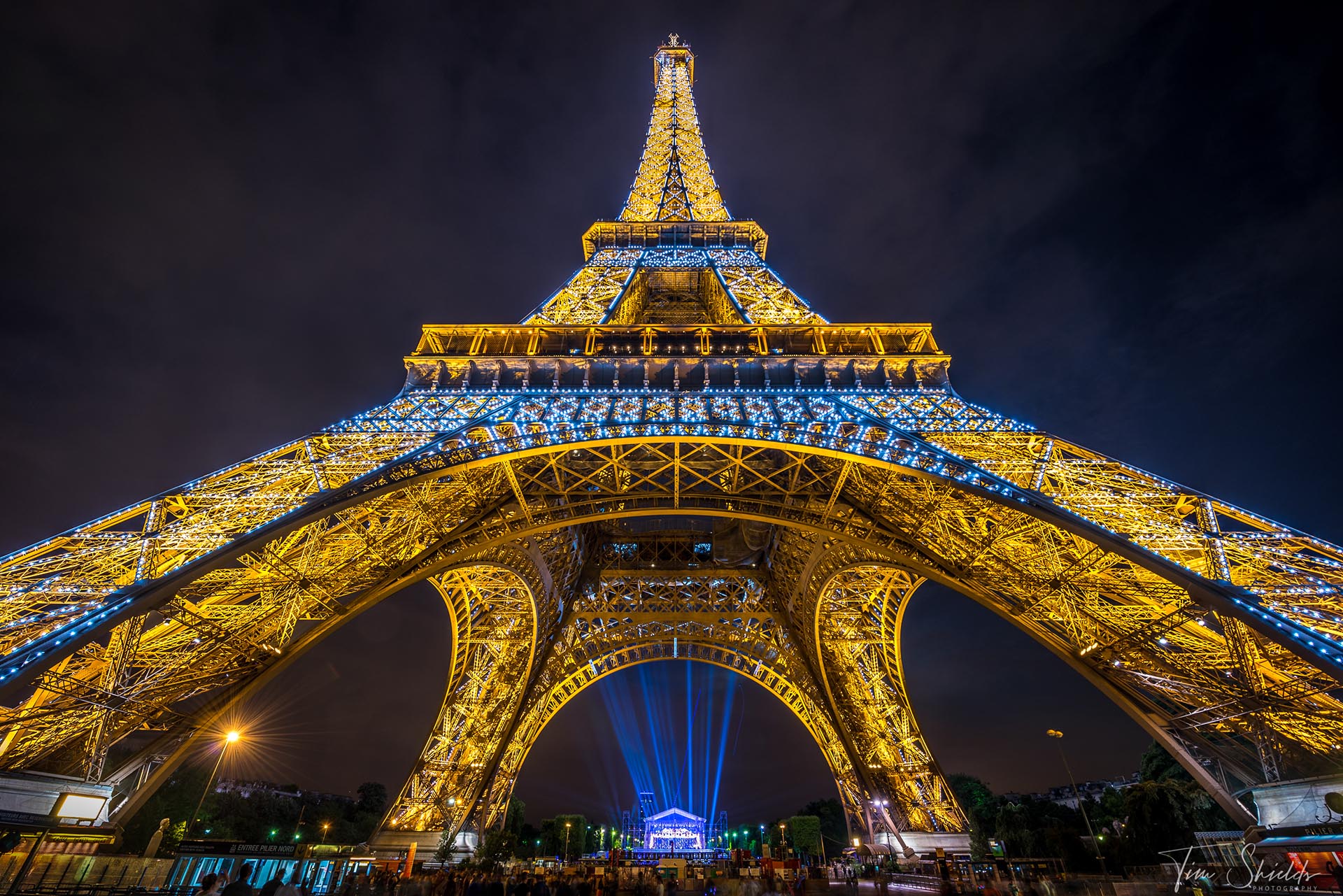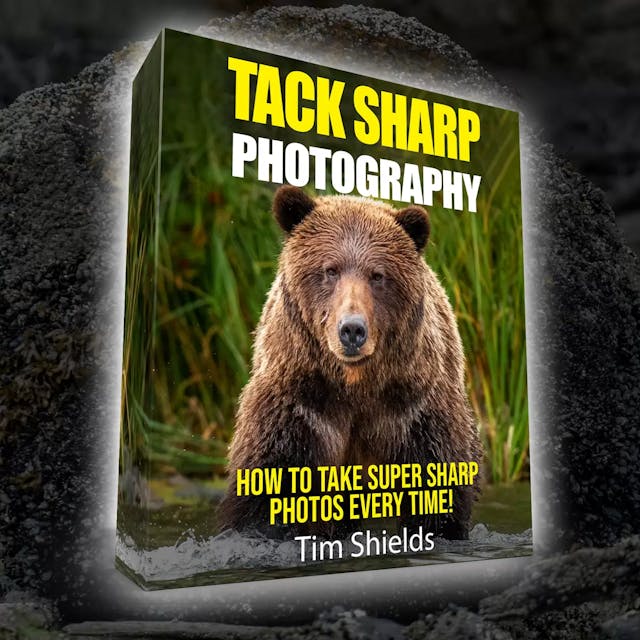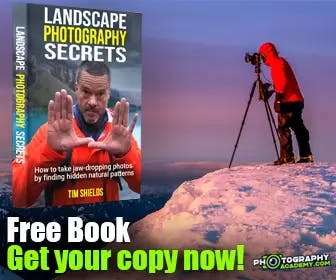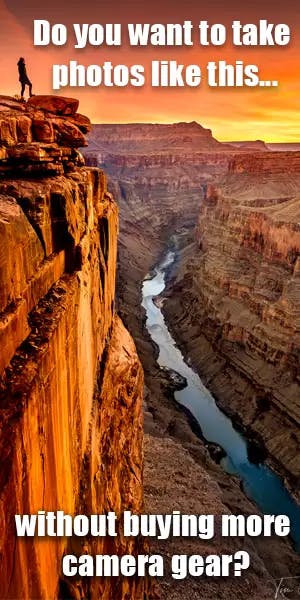Great photographs don’t happen without planning. This is a lesson that I repeat to my students all the time. You can’t just point a camera outside of a car window and expect that image to land in a gallery. And no professional photographer books a ticket to another part of the world without having planned the photos they want to take.
Take for example, Moraine Lake in Banff National Park. That location is an absolute treasure that brings in hundreds of thousands of people every single year. But you can’t just expect to go there out of the blue and get the perfect, iconic Moraine Lake image. The best views of that lake are at sunrise, when the golden glow of the sun hits the rock peaks.
Learning how to take photos often starts by standing on the shoulders of giants who came before. And even though some of the most iconic scenes have been photographed millions of times, yours will still be special. That day you go to the grand canyon will be different from any other day in history. But most importantly, that amazing image you take of an iconic landscape will be yours. And there’s something really cool about that.
This is the first article in my series about planning your images. This article will show you how to find the perfect location, and then planning the shot all the way down to where the sun is going to be facing, and the focal length that you need get that shot. The second article on the series, where I talk about how to find the perfect weather, including the conditions for a perfect sunset, can be found here.

What information do I need to plan a photograph?
You need to plan for the right place, composition, season, sun position, focal length, and camera settings. You’ll need to know if you’re going to bracket images, capture sun stars, and exactly where the sun is going to fall on the horizon. All of this will determine the equipment you need to get the shot, and what time of year you should plan to go.
If you’re shooting a distant building with a mountain landscape in the background, you’ll want to use a telephoto lens to make the mountains look bigger. If it’s a sweeping landscape with large leading lines, like the Grand Canyon, you’ll need a wide-angle lens to capture that majesty. And of course, if you’re bracketing the photos to create an HDR image, using a small aperture, or making a panorama, you’re going to need a good tripod.
Then, of course, depending on the landscape you’re in, you’ll need a rescue plan, or even a wildlife contingency plan. For example, If this happens in a foreign country, your cellphone might not connect to their network. Or if you’re in the Canadian Backcountry, you’ll need to plan for bears, which can completely ruin your trip.
What free tools can I use to plan a photograph?
These are the free tools that I use every single time I plan a photography trip:
- Google Reverse Image Search
- Google Maps
- SunCalc.org
I start my photo journey by finding amazing photographs on Instagram. There are all kinds of pages, like EarthHotSpots, or EarthOfficial that showcase the best landscape photographs on the Internet. If you’re interested in a certain region, the tourism board in that area will likely also have an Instagram account. Look these tourism board accounts up to find hidden gems. Once you find a photo that you really like, there are a few ways to find out where it is.
The easiest way is to look at the location on the top of the post. Some photographers don’t like to show their favorite locations and won’t post it, or will post fake location info on the post. That way, these locations don’t become the next places that are overrun with tourists all trying to get a similar spot.
 But if they don’t say where the image location is, there’s a simple trick to finding it every time. View the image on your computer, and take a screenshot. Use the built-in Snipping tool on PC, or press Cmd+Shift+F4 on Mac. Then go to images.google.com, and click the Camera Icon in the search bar to search by image. 9 times out of 10, Google Images will show you hundreds of images from the same location. Best of all, it’ll include links to websites showing these images, which will often tell you where in the world it’s located. Once you find the name of the location, type it into Google Maps.
But if they don’t say where the image location is, there’s a simple trick to finding it every time. View the image on your computer, and take a screenshot. Use the built-in Snipping tool on PC, or press Cmd+Shift+F4 on Mac. Then go to images.google.com, and click the Camera Icon in the search bar to search by image. 9 times out of 10, Google Images will show you hundreds of images from the same location. Best of all, it’ll include links to websites showing these images, which will often tell you where in the world it’s located. Once you find the name of the location, type it into Google Maps.

Using Google Maps to find the perfect photo location
Once you’ve got your location, Google Maps and Streetview will help you find the ideal vantage point for your photograph. Many people would be reluctant to go through this step, but it’s legitimately one of the most important parts. In some locations around the equator, the sunset may only last 30 minutes. Even in northern and southern latitudes, that perfect light might not stick around longer than the 5 minutes it takes to get your camera. So it’s important to know exactly where you’ll be. If you’re on vacation, chances are there’s going to be at least 100 other things on the schedule. So planning will make sure you know exactly what to do to get the shot.
When you find the spot on Google Maps, go into Satellite View on the bottom left-hand corner. This will give you a better look at the topography of the region. Using this, you can see what kind of access you’ll have to the location. Then, when you’re at your destination, grab the little yellow man in the bottom right-hand corner and drag him onto the scene. When you hold the man up, there will be blue lines for roads, and circles for photospheres. These photospheres are your best friend because they give you a 360-degree view of all the best locations in the world. If it’s a famous spot, someone has done a 360 sphere.
Using Google Street view to find the best vantage point on Moraine Lake

Take for example this spot on Moraine Lake. It’s a world-famous photo location in Banff National Park. I’ve been there myself for multiple photos, and I’ve known people who flew across the world just to catch a glimpse of this magnificent scene. There are almost 50 different photo spheres here to browse through. Use these to get an understanding of the land. Looking at the road access and the photospheres, you’ll see that it’s a short distance from your car to the scene and that there are photographers everywhere. But it’s not wheelchair accessible. So people that have trouble with stairs might have a hard time getting to the primary position.
By going to a few of these photosphere locations, you can see exactly what position you want to be in. If there are too many trees in the foreground, that could be a problem. Look around the photospheres to see if there’s a better vantage point that doesn’t have trees. Then, when you find that perfect position, you can drop a pin. Doing this on your desktop, you can save the link for the dropped pin in your favorites so it’s always accessible. Go to the same spot on your mobile phone, and touch and hold the position you want to drop a pin. When you do that, there’s an option at the bottom of the screen to save this pin. Once you’ve saved it, you’ll be able to navigate to it easily when you travel there.

Using Google Streetview Photosphere to find the right focal length
These are all wide-angle shots, so if the mountains are looking big in these photos, they’ll also be looking big using a wide-angle lens. But if the mountains look smaller than the photos you see on Instagram, that can be an indication that photographers are using a telephoto lens. Landscape photographers often use telephoto focal lengths between 70mm and 200mm for scenes.
In this case, because the mountains look huge in the frame, I know that I’ll be safe using my 16-35mm lens. I’ll definitely also be bringing my 70-200 f4 to capture close-up details if there are any interesting ones. Most times I also have my 24-70 f2.8 lens for safety, unless I really need to save weight. In this case, I can see that the location is really close to the parking lot. So it’s not a problem to bring that extra lens.
Planning your focal length in advance can be really important if you’re on a longer journey. Especially on vacation, it’s not going to be fun to carry around thousands of dollars in gear weighing over 50lbs. So if you’re planning a trip around a certain shop, you’re way better off if you know the focal length that you’ll need before you get to the location. That said, to be safe, I always recommend using zoom lenses over primes. Modern zooms are just as sharp as older primes, except they cover multiple focal lengths with a single lens. For the majority of landscape photography situations, I can get away with just one lens. The 24-70mm is the lens that’ll give you the most flexibility. 24mm is wide enough for most situations, and 70mm will give you a closer view for details. The 24-70 f2.8 on any system is the all-around winner.
What’s next?
 Stay tuned to this blog to see the next article on how to plan to capture your bucket list shot! And, in the meantime, if you’d like to learn more about photography, take a look at my free webclass! This course will show you my four-step system for capturing stunning photographs every time. It’s an easy to learn, effective process that I’ve used to capture award-winning photographs throughout my career.
Stay tuned to this blog to see the next article on how to plan to capture your bucket list shot! And, in the meantime, if you’d like to learn more about photography, take a look at my free webclass! This course will show you my four-step system for capturing stunning photographs every time. It’s an easy to learn, effective process that I’ve used to capture award-winning photographs throughout my career.





